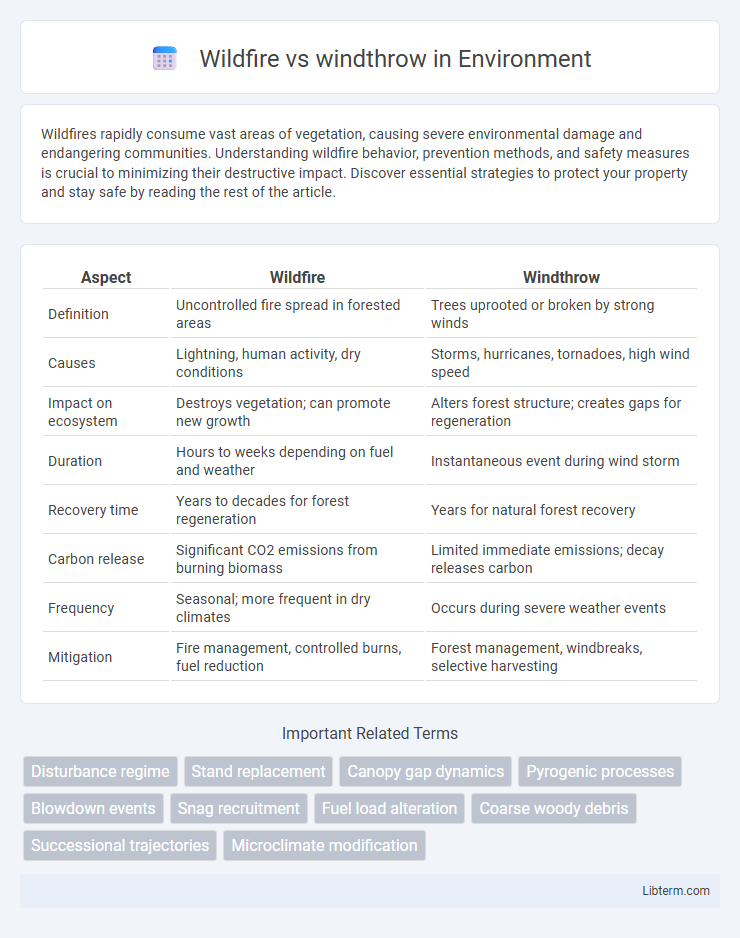Wildfires rapidly consume vast areas of vegetation, causing severe environmental damage and endangering communities. Understanding wildfire behavior, prevention methods, and safety measures is crucial to minimizing their destructive impact. Discover essential strategies to protect your property and stay safe by reading the rest of the article.
Table of Comparison
| Aspect | Wildfire | Windthrow |
|---|---|---|
| Definition | Uncontrolled fire spread in forested areas | Trees uprooted or broken by strong winds |
| Causes | Lightning, human activity, dry conditions | Storms, hurricanes, tornadoes, high wind speed |
| Impact on ecosystem | Destroys vegetation; can promote new growth | Alters forest structure; creates gaps for regeneration |
| Duration | Hours to weeks depending on fuel and weather | Instantaneous event during wind storm |
| Recovery time | Years to decades for forest regeneration | Years for natural forest recovery |
| Carbon release | Significant CO2 emissions from burning biomass | Limited immediate emissions; decay releases carbon |
| Frequency | Seasonal; more frequent in dry climates | Occurs during severe weather events |
| Mitigation | Fire management, controlled burns, fuel reduction | Forest management, windbreaks, selective harvesting |
Introduction to Wildfire and Windthrow
Wildfires are uncontrolled fires that rapidly spread across vegetation, fueled by dry conditions and wind, causing extensive ecological and economic damage. Windthrow refers to trees uprooted or broken by strong winds, resulting in altered forest structure and increased fuel for potential wildfires. Both phenomena significantly impact forest ecosystems, influencing succession patterns and risk management strategies.
Defining Wildfire: Causes and Characteristics
Wildfire refers to uncontrolled fires that rapidly spread across forested or grassland areas due to factors such as dry vegetation, high temperatures, and strong winds. These fires consume organic matter, drastically altering ecosystems by affecting soil composition, wildlife habitats, and air quality. Understanding wildfire behavior involves analyzing fuel types, ignition sources, and weather conditions that drive fire intensity and propagation.
Understanding Windthrow: Formation and Impact
Windthrow occurs when strong winds uproot or snap trees, causing significant damage to forest ecosystems by creating open gaps that alter microclimates and biodiversity. Unlike wildfires that consume vegetation through combustion, windthrow physically disrupts forest structure, often increasing fuel loads that may elevate future wildfire risks. Understanding windthrow helps in forest management strategies aimed at minimizing ecological impact and promoting recovery after storm disturbances.
Comparing Disturbance Patterns: Wildfire vs Windthrow
Wildfire disturbances typically create patchy, irregular burn patterns with varying intensities that influence forest regeneration and biodiversity differently from windthrow events, which generally result in contiguous areas of uprooted or snapped trees. Wildfire effects often lead to a mosaic of successional stages due to variable fire severity, while windthrow causes more uniform tree mortality but can create microsite variability from soil disturbance and canopy gaps. Understanding these distinct disturbance patterns is vital for forest management strategies aimed at enhancing ecosystem resilience and recovery processes.
Ecological Effects on Forest Structure
Wildfire drastically alters forest structure by removing biomass, creating open canopy gaps, and promoting early successional species, which enhances habitat diversity and nutrient cycling. Windthrow disrupts forest stability through uprooted or snapped trees, increasing coarse woody debris and modifying light availability, thus fostering heterogeneity in forest composition. Both disturbances contribute to long-term structural complexity but differ in spatial patterns and recovery trajectories critical for forest management planning.
Wildlife Responses to Wildfire and Windthrow
Wildfire and windthrow create distinct habitat changes that elicit varied wildlife responses; wildfire often leads to early successional habitats benefiting species like woodpeckers and certain songbirds, while windthrow results in increased coarse woody debris supporting decomposers and cavity-nesting mammals. Post-wildfire environments typically see a surge in insect populations, providing abundant food resources for birds and small mammals, whereas windthrow areas enhance habitat complexity, promoting biodiversity through shelter and nesting sites. Understanding these differential wildlife responses is crucial for effective forest management and conservation strategies aimed at maintaining ecological balance.
Soil and Nutrient Dynamics After Disturbance
Wildfire significantly alters soil nutrient dynamics by consuming organic matter, releasing nutrients such as nitrogen and phosphorus through combustion, which enhances nutrient availability but can also lead to volatilization losses. In contrast, windthrow causes physical disturbance by uprooting trees, leading to increased soil aeration and mixing of organic layers, which accelerates decomposition and nutrient cycling without the intense nutrient loss seen in wildfires. Both disturbances impact soil structure and fertility, but wildfires tend to cause more immediate nutrient depletion and changes in soil microbial communities compared to the episodic, spatially heterogeneous effects of windthrow.
Regeneration and Succession Processes
Wildfires create nutrient-rich ash beds that promote rapid regeneration of fire-adapted plant species, accelerating early successional stages and increasing biodiversity. In contrast, windthrow results in patchy canopy openings that facilitate diverse microhabitats, enhancing structural complexity and promoting gap-phase succession. Both disturbances influence forest dynamics differently, with wildfire favoring fast-growing pioneer species and windthrow supporting gradual forest recovery through microsite variation.
Forest Management Strategies for Each Disturbance
Forest management strategies for wildfire prioritize fuel reduction techniques such as controlled burns, mechanical thinning, and creating firebreaks to minimize fire intensity and spread. In contrast, windthrow management emphasizes maintaining tree species diversity, promoting structural heterogeneity, and implementing adaptive silviculture practices to enhance forest resilience against wind damage. Both strategies integrate monitoring systems and rapid response protocols tailored to the distinct disturbance dynamics of wildfire and windthrow events.
Climate Change Influence on Wildfire and Windthrow
Climate change significantly amplifies the frequency and intensity of wildfires by increasing temperatures and prolonging drought periods, which dry out vegetation and create more combustible fuel. In contrast, windthrow, the uprooting of trees by strong winds, is influenced by changes in storm patterns and extreme weather events linked to climate change, leading to more frequent and severe wind disturbances in forests. Both phenomena disrupt forest ecosystems, but wildfires tend to increase under warmer, drier conditions, while windthrow events escalate with amplified storm intensity and altered wind regimes driven by climate shifts.
Wildfire Infographic

 libterm.com
libterm.com